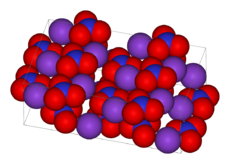Potassium nitrate
2007 Schools Wikipedia Selection. Related subjects: Chemical compounds
| Potassium nitrate | ||
|---|---|---|
 |
||
| General | ||
| Other names | Saltpetre Nitrate of potash |
|
| Molecular formula | KNO3 | |
| Molar mass | 101.1032 g/mol | |
| Appearance | white solid | |
| CAS number | [7757-79-1] | |
| Properties | ||
| Density and phase | 2.1 g/cm³, solid | |
| Solubility in water | 35.7 g/100 ml (25 °C) | |
| Melting point | 334 °C | |
| Boiling point | 400 °C decomp. | |
| Structure | ||
| Coordination geometry |
? | |
| Crystal structure | Orthorhombic, Aragonite | |
| Hazards | ||
| MSDS | External MSDS | |
| EU classification | ||
| NFPA 704 |
|
|
| R-phrases | ||
| S-phrases | ||
| Supplementary data page | ||
| Structure and properties |
n, εr, etc. | |
| Thermodynamic data |
Phase behaviour Solid, liquid, gas |
|
| Spectral data | UV, IR, NMR, MS | |
| Related compounds | ||
| Other anions | Potassium nitrite | |
| Other cations | Lithium nitrate Sodium nitrate Rubidium nitrate Caesium nitrate |
|
| Except where noted otherwise, data are given for materials in their standard state (at 25 °C, 100 kPa) Infobox disclaimer and references |
||
The chemical compound potassium nitrate is a naturally occurring mineral source of nitrogen. It is a nitrate with chemical formula KNO3.
Its common names include saltpetre (from Medieval Latin sal petrae: "stone salt" or possibly "Salt of Petra"), American English salt peter, Nitrate of potash and nitre. The name salt peter is also applied to sodium nitrate.
Description
Potassium nitrate is the oxidizing (oxygen-supplying) component of black powder. Prior to the large-scale industrial fixation of nitrogen through the Haber process, a major source of Potassium nitrate was the deposits crystallising from cave walls or the drainings of decomposing organic material. Dung-heaps were a particularly common source: ammonia from the decomposition of urea and other nitrogenous materials would undergo bacterial oxidation to produce nitrate. It was and is also used as a component in some fertilizers. When used by itself as a fertilizer, it has an NPK rating of 13-0-44 (indicating 13%, 0%, and 44% of nitrogen, phosphorus, and potassium, by mass, respectively).
Manufacture
Historically, nitre-beds were prepared by mixing manure with either mortar or wood ashes, common earth and organic materials such as straw to give porosity to a compost pile typically 1.5 metres high by 2 metres wide by 5 metres long. The heap was usually under a cover from the rain, kept moist with urine, turned often to accelerate the decomposition and leached with water after approximately one year. The liquid containing various nitrates was then converted with wood ashes to potassium nitrates, crystallized and refined for use in gunpowder. Today, most potassium nitrate comes from the vast deposits of sodium nitrate (NaNO3, nitratine) in the Chilean deserts. The sodium nitrate is purified and then reacted in solution with potassium chloride (KCl, sylvite), from which the less-soluble potassium nitrate is precipitated out.
In England, the privilege of manufacturing explosives had been in the hands of the family of John Evelyn, the celebrated diarist, as a crown monopoly since before 1588.
Applications
One of the most useful applications of potassium nitrate is in the production of nitric acid, by adding concentrated sulfuric acid to an aqueous solution of potassium nitrate, yielding nitric acid and potassium sulfate which are separated through fractional distillation.
Potassium nitrate is also used as a fertilizer, in model rocket propellant, and in several fireworks such as smoke bombs, in which a mixture with sugar produces a smoke cloud of 600 times their own volume. The ratio for smoke bombs using sucrose (powdered sugar) and potassium nitrate is 40(C12H22O11):60(KNO3). It can be used as is, or carefully melted together using a hot plate.
In the process of food preservation, potassium nitrate is a rare ingredient of salted meat, but there are theories indicating that using nitrates in meats can cause cancer. As a preservative it can be known as E252.
Potassium Nitrate is also a main component in stump remover; it accelerates the natural decomposition of the stump. Stump remover is usually about 98% pure KNO3, and is a common source of KNO3.
It has also been used in the manufacture of ice cream and can be found in some toothpastes for sensitive teeth. Recently, the use of potassium nitrate in toothpastes for sensitive teeth has increased dramatically, despite the fact that it has not been conclusively shown to help dental hypersensitivity.
A popular misconception is that potassium nitrate is an anaphrodisiac and was added to food in all-male institutions. In fact, potassium nitrate has no such effect in humans.
Although potassium nitrate is used in gunpowder, by itself, potassium nitrate is not combustible or flammable.

